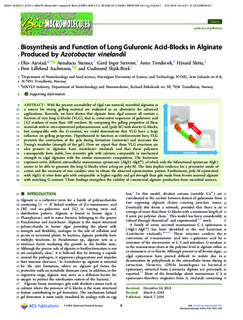| dc.contributor.author | Aarstad, Olav Andreas | |
| dc.contributor.author | Stanisci, Annalucia | |
| dc.contributor.author | Sætrom, Gerd Inger | |
| dc.contributor.author | Tøndervik, Anne | |
| dc.contributor.author | Sletta, Håvard | |
| dc.contributor.author | Aachmann, Finn Lillelund | |
| dc.contributor.author | Skjåk-Bræk, Gudmund | |
| dc.date.accessioned | 2020-03-17T09:10:47Z | |
| dc.date.available | 2020-03-17T09:10:47Z | |
| dc.date.created | 2019-06-18T09:16:13Z | |
| dc.date.issued | 2019 | |
| dc.identifier.citation | Biomacromolecules. 2019, 20 (4), 1613-1622. | nb_NO |
| dc.identifier.issn | 1525-7797 | |
| dc.identifier.uri | http://hdl.handle.net/11250/2647103 | |
| dc.description | This document is the unedited Author’s version of a Submitted Work that was subsequently accepted for publication in Biomacromolecules , copyright © American Chemical Society after peer review. To access the final edited and published work see https://doi.org/10.1021/acs.biomac.8b01796 | nb_NO |
| dc.description.abstract | With the present accessibility of algal raw material, microbial alginates as a source for strong gelling material are evaluated as an alternative for advanced applications. Recently, we have shown that alginate from algal sources all contain a fraction of very long G-blocks (VLG), that is, consecutive sequences of guluronic acid (G) residues of more than 100 residues. By comparing the gelling properties of these materials with in vitro epimerized polymannuronic acid (poly-M) with shorter G-blocks, but comparable with the G-content, we could demonstrate that VLG have a large influence on gelling properties. Hypothesized to function as reinforcement bars, VLG prevents the contraction of the gels during formation (syneresis) and increases the Young’s modulus (strength of the gel). Here we report that these VLG structures are also present in alginates from Azotobacter vinelandii and that these polymers consequently form stable, low syneretic gels with calcium, comparable in mechanical strength to algal alginates with the similar monomeric composition. The bacterium expresses seven different extracellular mannuronan epimerases (AlgE1-AlgE7), of which only the bifunctional epimerase AlgE1 seems to be able to generate the long G-blocks when acting on poly-M. The data implies evidence for a processive mode of action and the necessity of two catalytic sites to obtain the observed epimerization pattern. Furthermore, poly-M epimerized with AlgE1 in vitro form gels with comparable or higher rigidity and gel strength than gels made from brown seaweed alginate with matching G-content. These findings strengthen the viability of commercial alginate production from microbial sources. | nb_NO |
| dc.language.iso | eng | nb_NO |
| dc.publisher | ACS | nb_NO |
| dc.title | Biosynthesis and Function of Long Guluronic Acid-Blocks in Alginate Produced by Azotobacter vinelandii | nb_NO |
| dc.type | Journal article | nb_NO |
| dc.type | Peer reviewed | nb_NO |
| dc.description.version | acceptedVersion | nb_NO |
| dc.source.pagenumber | 1613-1622 | nb_NO |
| dc.source.volume | 20 | nb_NO |
| dc.source.journal | Biomacromolecules | nb_NO |
| dc.source.issue | 4 | nb_NO |
| dc.identifier.doi | 10.1021/acs.biomac.8b01796 | |
| dc.identifier.cristin | 1705510 | |
| dc.relation.project | Norges forskningsråd: 221576 | nb_NO |
| dc.relation.project | Norges forskningsråd: 250875 | nb_NO |
| cristin.unitcode | 194,66,15,0 | |
| cristin.unitname | Institutt for bioteknologi og matvitenskap | |
| cristin.ispublished | true | |
| cristin.fulltext | postprint | |
| cristin.fulltext | preprint | |
| cristin.qualitycode | 1 | |
